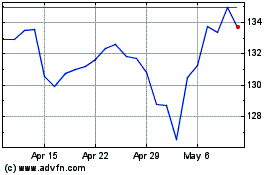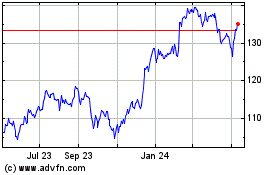By Paul Vigna and Anna Hirtenstein
Bitcoin climbed back above $18,000 last week to flirt with
record levels, a spectacular rally driven by a new group of buyers
seeking the opportunity for big profits.
The digital currency traded as high as $18,965 on Friday,
according to CoinDesk, about 4% below its all-time high of $19,783
set in December 2017. It has surged more than 50% in the past month
alone.
The rally has attracted a wide cast of characters, from the Wall
Street billionaires Paul Tudor Jones and Stanley Druckenmiller to
momentum investors who aim to ride winning assets higher and losing
markets lower.
Their participation, in turn, has fueled more buying, which
mirrors a similar dynamic playing out in stocks such as Tesla Inc.,
which investors keep pushing higher with little regard for
fundamentals. As in 2017, when bitcoin became a cultural
phenomenon, much of the hype has traveled by word-of-mouth.
Lately, bitcoin has even been a winning topic on sports radio.
Gregg Giannotti, co-host of the "Boomer & Gio" morning
sports-talk radio show on WFAN in New York, has been talking up the
cryptocurrency on the air after investing $10,000 earlier this
month.
There was a strong response to the bitcoin segments, Mr.
Giannotti said. "As soon as I brought it up on the air, it
started," he said, adding that old friends wrote to him, sales
people wanted to talk about bitcoin and listeners jammed his
Twitter feed. "It struck a nerve," he said.
Bitcoin, a form of money that exists only digitally, started in
January 2009 during the depths of the financial crisis and was
positioned as an alternative to government-backed money. It
operates across a network of linked but independent computers that
can't be controlled by any one party, such as a central bank.
It was designed to have a fixed supply that would make it
resistant to inflation. With central banks pledging this year to
push up inflation, more investors have been willing to test bitcoin
as a hedge. Its potential, however, has been difficult to gauge
because inflation hasn't reached the Federal Reserve's target of 2%
in years.
Aiding this interest has been the increasing number of
mainstream platforms that facilitate bitcoin trading. The
combination of accessible platforms and bitcoin's potential as an
inflation hedge is what is primarily driving the cryptocurrency
this year, said Dan Morehead, chief executive of Pantera Capital, a
venture fund that has been investing in the sector since 2013.
"Paper money is being debased, and bitcoin is not," he said.
The last time bitcoin attracted such attention -- in the fourth
quarter of 2017, when it nearly quadrupled to approach $20,000 --
the industry wasn't prepared. There were few outlets for trading
beyond startup exchanges, and bitcoin had little practical value.
The momentum washed out, new investors disappeared, venture capital
dried up and the industry went through a wave of retrenchment and
layoffs.
Much of that has changed, bulls argue. For one thing, the
regulatory landscape is much clearer than it was in 2017. State and
federal agencies, including the Internal Revenue Service and the
Securities and Exchange Commission, have laid out rules for the
treatment of cryptocurrencies. That has led companies such as CME
Group Inc., Intercontinental Exchange Inc. and Fidelity Investments
Inc. to offer services for buying and selling crypto assets.
There are also retail-oriented platforms catering to interest in
crypto trading. Volume has surged at Square Inc.'s Cash App, which
has allowed customers to buy and sell bitcoin since 2018. In the
third quarter, customers bought $1.6 billion of bitcoin, up from
$555 million the year before.
In October, PayPal Holdings Inc. unveiled a service that allows
its users to buy and sell bitcoin directly in their accounts. It
became available to all U.S. users on Nov. 12 and will expand to
Venmo and some international markets next year.
Grayscale Investments, a private fund manager that sells 10
over-the-counter trust funds focused on bitcoin and other
cryptocurrencies, has benefited from the new interest. The firm
reported Tuesdaythat its assets under management had risen to more
than $10 billion from $5.9 billion at the end of September.
Despite the recent growth, the bitcoin market is still tiny
compared with other assets, which contributes to its volatility.
Pantera estimated that trading volumes on PayPal and on Square's
Cash App alone would exceed the amount of new bitcoin being created
daily.
With hedge funds and other professionals also buying, supply
will become even more constrained, according to Pantera Capital's
Mr. Morehead. "The only way supply and demand equilibrates is at a
higher price," he said.
That dynamic is part of what attracted Mr. Druckenmiller. He
sees bitcoin as similar to gold, he told CNBC in an interview
earlier this month, but because of bitcoin's smaller size and
volatility, he believes it could outperform the precious metal. Mr.
Jones told the network in May that he put about 1% to 2% of his
assets in bitcoin, calling it a "great speculation" that he
believes will emerge as a new asset class.
Neither Mr. Druckenmiller nor Mr. Jones responded to requests
for comment.
Still, bitcoin's history shows exactly how volatile and risky it
can be for investors. Its price fell as low as $3,867 on March 13,
when global markets cratered, a drop of more than 60% from the
beginning of the year. Bitcoin lost about 50% of its value in
January 2018 after the spectacular 2017 run, eventually sinking to
as low as $3,122 by December 2018.
Those risks haven't deterred investors such as Wayne Sharp, a
retired investment adviser in Columbus, Ohio, who bought her first
bitcoin in September, investing $10,000. She said she was swayed by
arguments about bitcoin's value as an inflation hedge, as well as
the respectability conferred by investors including Mr. Jones.
She acknowledged the purchase was speculative but said she is
tired of watching safer, "value" investments fall behind momentum
trades. She put a small amount of her wealth into the
cryptocurrency and said she might buy more down the road.
"I figure what the heck, just go for it," she said.
Write to Paul Vigna at paul.vigna@wsj.com and Anna Hirtenstein
at anna.hirtenstein@wsj.com
(END) Dow Jones Newswires
November 23, 2020 05:44 ET (10:44 GMT)
Copyright (c) 2020 Dow Jones & Company, Inc.
Intercontinental Exchange (NYSE:ICE)
Historical Stock Chart
From Mar 2024 to Apr 2024

Intercontinental Exchange (NYSE:ICE)
Historical Stock Chart
From Apr 2023 to Apr 2024
